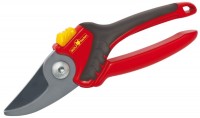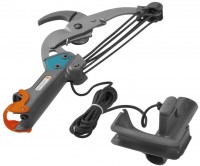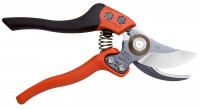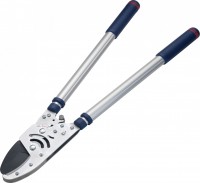Garden Shears GARDENA
All Garden Shears Advanced filters → |
You might be interested in
Garden Shears: specifications, types
Show all
Type
This tool in most cases is manual and mechanical, requiring physical impact. However, at the turn of 2021 and 2022, battery versions began to appear, simplifying work. Most of the tools below can be either mechanical or cordless. More details about them:
- Secateurs. A fairly simple and easy-to-use garden tool designed for cutting branches, small shoots on the crowns of trees, shrubs, harvesting grapes and solving ot...her similar problems. Outwardly similar to scissors and can be used either with two hands or with one, depending on the design. Secateurs can have different lengths of handles and blades, as well as the configuration of the working part. The classic model consists of two blades - a support blade and a working blade. The first serves to securely fix the branch or shoot during work, as well as to prevent the branch from jumping to the side after cutting. To cut large branches with a size of 3-4 cm, the pruning shears are reinforced with long handles and a ratchet mechanism.
— Scissors. Garden shears already have two blades in the working area and are used for trimming thin branches, stems, grass, etc. They are characterized by straight blades and an extremely simple design. They may vary in the shape of the blades, the type of cutting edge, as well as the length and size of the handle. For example, scissors with a serrated or wavy edge are good because the branches and shoots being cut do not slide along the blade; these are often used for trimming climbing plants. And if you need to deal with particularly thick and durable shoots, then garden shears with a serrated blade are suitable for this task.
- Lopper. Garden tool for cutting branches and knots. As with pruning shears, the working area has a sharpened blade and a stop. But at the same time, the product is distinguished by long handles (usually from 30 cm to 90 cm) and allows you to work with vegetation located on the lower branches of the tree. The handles form a lever, so it is important to hold them with both hands. The tool is convenient for processing trees with a dense crown, cutting branches of thorny bushes, etc.
- Height cutter. A special type of garden tool, mainly intended for processing tree crowns or trimming fruit branches without the use of a ladder or stepladder. The product is distinguished by elongated telescopic handles - from 1 to 4 m, thanks to which the customer can work while standing on the ground. A special mechanism is built into the handle that allows you to control the decisive tool. Often, pole saws are equipped with saw blades.
— Vaccination. A tool for making special cuts necessary for scion and rootstock in the process of grafting trees. It is characterized by the presence of a figured knife, with which sLR cuts are made. Different types of grafting pruners can be equipped with blades of different configurations, and in universal models one working blade can easily be replaced by another. Different blade shapes are necessary to graft different types of trees. The advantages include the fact that with the help of this tool the process of grafting shoots is greatly simplified and accelerated. On the other hand, grafting pruners are only effective if the shoots are approximately the same size, otherwise you will have to use a knife.
- Secateurs. A fairly simple and easy-to-use garden tool designed for cutting branches, small shoots on the crowns of trees, shrubs, harvesting grapes and solving ot...her similar problems. Outwardly similar to scissors and can be used either with two hands or with one, depending on the design. Secateurs can have different lengths of handles and blades, as well as the configuration of the working part. The classic model consists of two blades - a support blade and a working blade. The first serves to securely fix the branch or shoot during work, as well as to prevent the branch from jumping to the side after cutting. To cut large branches with a size of 3-4 cm, the pruning shears are reinforced with long handles and a ratchet mechanism.
— Scissors. Garden shears already have two blades in the working area and are used for trimming thin branches, stems, grass, etc. They are characterized by straight blades and an extremely simple design. They may vary in the shape of the blades, the type of cutting edge, as well as the length and size of the handle. For example, scissors with a serrated or wavy edge are good because the branches and shoots being cut do not slide along the blade; these are often used for trimming climbing plants. And if you need to deal with particularly thick and durable shoots, then garden shears with a serrated blade are suitable for this task.
- Lopper. Garden tool for cutting branches and knots. As with pruning shears, the working area has a sharpened blade and a stop. But at the same time, the product is distinguished by long handles (usually from 30 cm to 90 cm) and allows you to work with vegetation located on the lower branches of the tree. The handles form a lever, so it is important to hold them with both hands. The tool is convenient for processing trees with a dense crown, cutting branches of thorny bushes, etc.
- Height cutter. A special type of garden tool, mainly intended for processing tree crowns or trimming fruit branches without the use of a ladder or stepladder. The product is distinguished by elongated telescopic handles - from 1 to 4 m, thanks to which the customer can work while standing on the ground. A special mechanism is built into the handle that allows you to control the decisive tool. Often, pole saws are equipped with saw blades.
— Vaccination. A tool for making special cuts necessary for scion and rootstock in the process of grafting trees. It is characterized by the presence of a figured knife, with which sLR cuts are made. Different types of grafting pruners can be equipped with blades of different configurations, and in universal models one working blade can easily be replaced by another. Different blade shapes are necessary to graft different types of trees. The advantages include the fact that with the help of this tool the process of grafting shoots is greatly simplified and accelerated. On the other hand, grafting pruners are only effective if the shoots are approximately the same size, otherwise you will have to use a knife.
Design
— One-handed. Tools designed to be held in one hand while working. Thus, the second hand remains free, which is important in some situations — for example, when working at height, when you need to hold on to something just in case. Another advantage is portability: the tool is light and compact, many models can be easily carried in your pocket. The main drawback of the one-handed design is the relatively small force on the blades and, accordingly, the low efficiency when working with thick branc...hes. Because of this, models with a maximum cutting diameter of more than 25 mm are extremely rare among such tools. The same applies to high cutters — for them, a two-handed layout is technically more convenient.
— Two-handed. Models designed to be held with two hands during operation. Usually, these are rather large instruments with long handles; the latter allows you to achieve high force on the blades and even cope with fairly thick branches without problems. The specific thickness limitation may, of course, vary; however, for example, all loppers are by definition two-handed. The disadvantages of this design are considered primarily bulky and rather significant weight, but they are offset by high efficiency. But a more critical point may be that during operation both hands of the user are busy: this, in particular, makes it difficult to work in an unstable position, especially at height.
— Two-handed. Models designed to be held with two hands during operation. Usually, these are rather large instruments with long handles; the latter allows you to achieve high force on the blades and even cope with fairly thick branches without problems. The specific thickness limitation may, of course, vary; however, for example, all loppers are by definition two-handed. The disadvantages of this design are considered primarily bulky and rather significant weight, but they are offset by high efficiency. But a more critical point may be that during operation both hands of the user are busy: this, in particular, makes it difficult to work in an unstable position, especially at height.
left-handed
Instruments that initially allowed left-handed use. These can be both specialized instruments, originally created for the left hand, and "two-handed" models that are equally well suited for both right-handers and left-handers. Anyway, this feature in our catalog is indicated only if the suitability for left-handers is expressly claimed by the manufacturer.
Pole saw drive
The design of the drive used in the pole saw (see "Type").
The drive is a flexible or rigid rod that transfers force from the user's hands to the blades of the tool. At the same time, it is customary to separate such thrusts not by flexibility / rigidity, but by location, the options can be as follows:
— Internal. The drive located inside the handle (bar) of the pole saw. This design provides excellent protection for the mechanism of the tool: the likelihood of moving par...ts coming into contact with branches and other foreign objects is minimized. Pole saws with this type of drive are by definition equipped with rods (see below) and can be used out of the box, unlike outdoor models; however, the "native" bar cannot be removed and replaced with another, which can create inconvenience in some situations.
— Outdoor. Drive located outside the pole saw. To be more precise, most of these tools are bits with blades and a drive, which are not equipped with rods at all. This creates additional hassle in preparation for work. On the other hand, the user can choose the bar at his discretion and, if necessary, easily change it; and if necessary, even an ordinary wooden stick, like a mop handle, can play the role of a rod.
The drive is a flexible or rigid rod that transfers force from the user's hands to the blades of the tool. At the same time, it is customary to separate such thrusts not by flexibility / rigidity, but by location, the options can be as follows:
— Internal. The drive located inside the handle (bar) of the pole saw. This design provides excellent protection for the mechanism of the tool: the likelihood of moving par...ts coming into contact with branches and other foreign objects is minimized. Pole saws with this type of drive are by definition equipped with rods (see below) and can be used out of the box, unlike outdoor models; however, the "native" bar cannot be removed and replaced with another, which can create inconvenience in some situations.
— Outdoor. Drive located outside the pole saw. To be more precise, most of these tools are bits with blades and a drive, which are not equipped with rods at all. This creates additional hassle in preparation for work. On the other hand, the user can choose the bar at his discretion and, if necessary, easily change it; and if necessary, even an ordinary wooden stick, like a mop handle, can play the role of a rod.
Max. cutting diameter
The largest diameter (thickness) of a branch that the tool can handle.
The larger the maximum cut diameter, the more powerful this model, the lower the likelihood that a certain branch will be too tough for the tool. At the same time, note that to ensure high power, long handles and strong blades are needed, which accordingly affects the dimensions, weight and price. Therefore, it is worth choosing according to this parameter with a certain margin, but at the same time, this margin sho...uld not be too large.
As for specific figures, a maximum diameter of 20 mm or less is considered relatively small, but it often turns out to be quite enough for simple work. 21 – 30 mm — the average value, 31 – 40 mm — above average, and in loppers the maximum thickness can exceed 40 mm.
The larger the maximum cut diameter, the more powerful this model, the lower the likelihood that a certain branch will be too tough for the tool. At the same time, note that to ensure high power, long handles and strong blades are needed, which accordingly affects the dimensions, weight and price. Therefore, it is worth choosing according to this parameter with a certain margin, but at the same time, this margin sho...uld not be too large.
As for specific figures, a maximum diameter of 20 mm or less is considered relatively small, but it often turns out to be quite enough for simple work. 21 – 30 mm — the average value, 31 – 40 mm — above average, and in loppers the maximum thickness can exceed 40 mm.
Blade length
The length of the blades provided in the tool. Usually, the characteristics indicate the working length of the blades — from the tip to the rotary axis.
Both long and short blades have their own specifics, advantages and disadvantages. So, the long length is optimal for working with relatively thin branches: it allows you to cut several of them at a time, and also makes it possible to reach into hard-to-reach places. At the same time, short blades are more compact and provide more forc...e for the same length of handles, which is convenient when working with thick branches. More detailed recommendations on choosing the length of the blades for a specific situation can be found in special sources.
Both long and short blades have their own specifics, advantages and disadvantages. So, the long length is optimal for working with relatively thin branches: it allows you to cut several of them at a time, and also makes it possible to reach into hard-to-reach places. At the same time, short blades are more compact and provide more forc...e for the same length of handles, which is convenient when working with thick branches. More detailed recommendations on choosing the length of the blades for a specific situation can be found in special sources.














